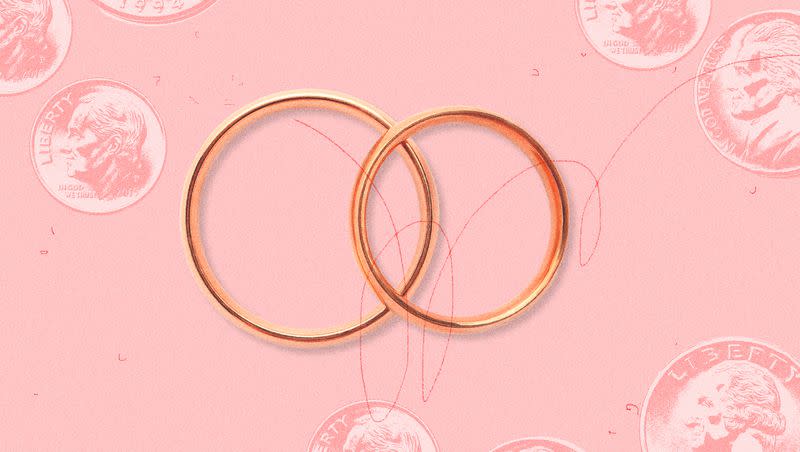Perspective: Crowdfunded weddings might be a good thing

As a 24-year-old Ivy League graduate, I left a doctoral program in English literature to get married.
If that sounds like something out of 1952 instead of 2012, well, I guess it wasn’t quite that simple. But, for a host of reasons, it had become untenable for me to complete my dissertation while living a few hours away from campus with my future husband. We’d met as undergraduates, he was attending law school, and we intended to start a family. So I forsook the Ph.D. that I’d long intended to serve as the cornerstone of my professional future.
Despite the work I’d already put in and the professional ambitions that rested squarely on the attainment of that degree, it was an easy decision.
Why?
Because my husband and I took for granted that marriage would be the cornerstone of our broader lives, and that everything else could and would be pursued from that vantage point. Anything that was going to delay our ability to establish roots together past our mid-20s, as it had become clear my completion of this doctoral program would do, was a thing best forgone. We could — and did — say “I do” without graduate degrees, a house, steady employment or financial security. In the 11 years since our wedding, we’ve obtained advanced degrees, a home and various jobs. We’ve also had three children.
In this trajectory, my husband and I are throwbacks and outliers.
Since the 1970s, the age of marriage has steadily climbed, while its ubiquity has faltered. A view of marriage not as the cornerstone of adult life (on top of which everything else is layered) but as its capstone (to be added after all the other markers of adult life have been achieved) is now an established norm among Americans with college degrees. Meanwhile, marriage itself has become a luxury good. Among Americans without college degrees, marriage is increasingly rare altogether.
Attendant to the decline of marriage is the alarming fact that Americans are reproducing at a rate well below replacement level, and the sad reality that many women enter mid-life wishing they’d had more children.
The broad return to a cornerstone view of marriage and its corollary — earlier and more childbearing among married Americans — seems the obvious solution to all of these problems. It would also provide a needed counter to the pervasive societal scourge of extended adolescence, particularly among men.
That’s why I find two new, and on first glance unseemly, trends around marriage rather hopeful.
Related
When a friend recently told me that she was attending a wedding for which those invited were asked to pay for their own places rather than being traditional guests, I found the concept a bit strange. And when I first started to see reports of couples requesting donations to a house fund rather than cutlery and sheets, I found it curious.
But, upon reflection, I think that these attempts to afford weddings and homes — in a market where even modest nuptial celebrations and houses have become exorbitantly expensive and out of reach for the average person of any age — are unconsciously harkening back to the view of marriage as the foundation upon which adult life gets built, rather than the icing on an already finished cake.
After all, it is impracticable for marriage to be a broadly foundational institution if it is not also a broadly communal one.
My parents paid for my wedding, but if they had not done so, my husband and I would have either had to delay getting married or exchange vows without even a simple reception. Today’s wedding industrial complex is perversely built on the inability of young couples to afford weddings. As nuptial norms become ever more lavish, the capacity of normal people to afford those norms continues to diminish.
But not so long ago, it was only the wealthy who were expected to independently foot the bill for a wedding. In generations past, extended families, neighbors and friends came together to throw genuinely “DIY” celebrations of marriage. In a sense, the attempt to fund a wedding through contributions of friends, family and strangers is a resurgence of this idea, albeit in a seemingly impersonal and vaguely off-putting online context.
Meanwhile, the cost of material items used to be far higher relative to other expenses than it is today. So, wedding shower gifts like toasters and towels were once useful to a couple just starting out. Today, by contrast, a toaster costs not much more in actual dollars than it did 50 years ago. The average price of a home, however, is more than nine times what it was then, a difference that outpaces inflation by a significant amount and growth in wages by even more. Rent in and around many major cities is also exorbitant. So, asking family and friends to contribute to a down payment for a home seems like a reasonable use of wedding guests’ good will.
There are obviously myriad economic and cultural reasons why marriage is in decline. No crowdfunded reception or housing fund is going to change that. But, unlike almost every other trend of the past 60 years, these trends are at least based on an implicit view of marriage as a cornerstone — which is the necessary foundation for marriage making a cultural comeback.
Elizabeth Grace Matthew is a visiting fellow at Independent Women’s Forum, a Young Voices contributor and a regular opinion contributor at The Hill.

